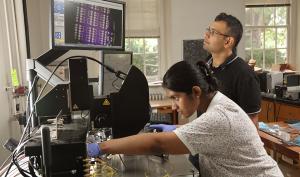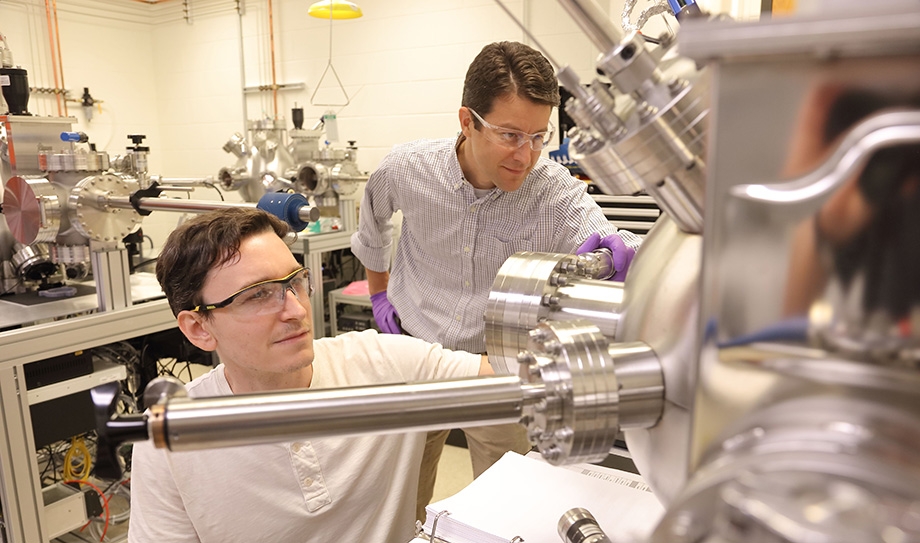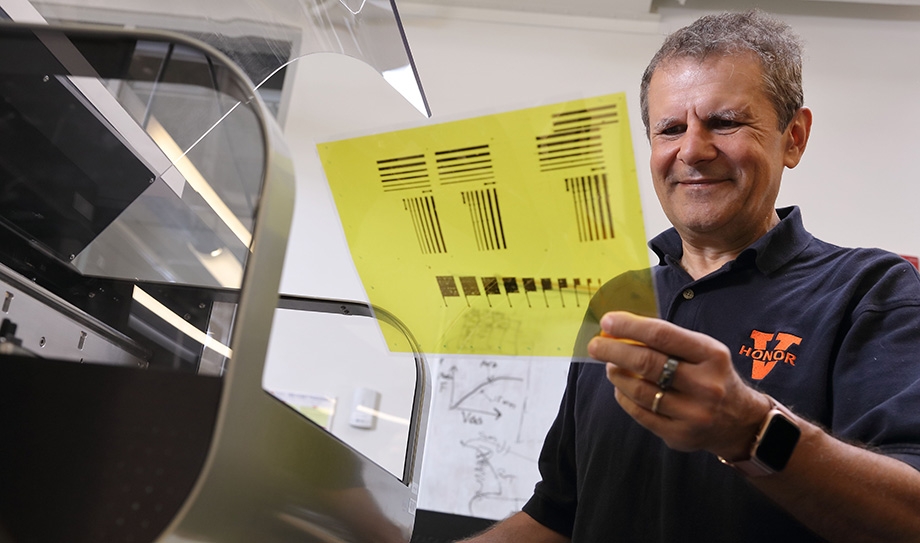
Real-world needs for such complex services as efficient manufacturing, drug discovery, supply chain logistics and wireless communication have outpaced the computing resources of today’s conventional computers — there are simply too many variables and constraints for a digital machine to calculate efficiently.
Acknowledging this, researchers at the University of Virginia’s School of Engineering and Applied Science and Pennsylvania State University are pursuing a dramatically different hardware platform that can generate solutions while satisfying all the constraints imposed by real-world users and conditions.
The team — led by Nikhil Shukla, a UVA assistant professor with a joint appointment in electrical and computer engineering and materials science and engineering — envisions an alternative to digital computing and its rules-based operation: a platform that allows the natural physics of oscillators and their synchrony to do the computing.
Instead of computing with ones and zeros like digital computers, a solution emerges from the spatial-temporal properties of the system — the behavior of one oscillator with respect to others — over time. The team’s proposed hardware platform, named FerroCoDE, will compute in the analog domain to exploit the rich spatial and temporal characteristics of the underlying devices and circuits.
“We approach the hardware platform design as a systems challenge,” Shukla said.
The FerroCoDE platform has earned a four-year, $1.5 million grant from the National Science Foundation’s Addressing Systems Challenges through Engineering Teams — commonly known as ASCENT — a program of the Electrical, Communications and Cyber Systems Division. The ASCENT grant enables the team members to undertake a cohesive, across-the-stack effort to develop Shukla’s physics-inspired computational model into a working machine.

“Not all computing problems are created equal,” Shukla said. “At the heart of many increasingly important applications — ranging from the design of intelligent machines that can explain their decisions to electronic design automation for tamper-proof integrated circuits — lies a class of combinatorial optimization problems that remain an unconquered bastion of traditional digital computing.”
Shukla is referring to the Boolean satisfiability problem, an archetype in computational theory. It is characterized by an exponential increase in the number of variables and constraints based on the scope, reach and complexity of the real-world problem to which it corresponds. Solving the Boolean satisfiability problem requires exponentially increasing energy and computation time.
The FerroCoDE platform team includes Jon Ihlefeld, an associate professor of materials science and engineering and electrical and computer engineering at UVA who is leading materials innovation for this effort. Shukla will incorporate these new materials in his prototype devices, which he will embed and connect to circuits designed by Mircea Stan, Virginia Microelectronics Consortium Professor of electrical and computer engineering. Vijaykrishnan Narayanan, the A. Robert Noll Chair of computer science and engineering and electrical engineering at Penn State, will design the architecture for the system as a whole.
The team will engineer electronic materials — synergistically designed with novel ways of data processing — to dramatically boost efficiency. Ihlefeld specializes in a class of electronic materials called ferroelectrics, which are the electrical analogs to ferromagnets. Instead of a switchable north and south pole, they have a switchable positive and negative polarization, or surface charge. The team’s preferred ferroelectric material is hafnium oxide because it is compatible with state-of-the-art silicon-process technology.
The challenge is that hafnium oxide’s polarization value is too large for the devices Shukla has in mind. By manipulating the microstructure and the composition of the hafnium oxide, Ihlefeld can bring polarization down in a way that preserves reliability and allows Shukla to make any size device from a nanometer to a micron.
“The underlying physics of the oscillator array is efficient and fast, but to be successful, the platform needs to capture the state of the oscillators and work with conventional digital computers and their many user applications,” said Stan, the project’s circuit designer.
The ASCENT grant builds on a UVA Engineering research innovation award that enabled Ihlefeld and Shukla to build synergies between ferroelectric materials and devices. Additionally, the grant leverages Ihlefeld’s and Narayanan’s collaborative effort to gain fundamental insight and understanding of how to manipulate hafnium oxide. Both researchers are members of the Center for 3D Ferroelectric Microelectronics, a Department of Energy Frontier Research Center.
The ASCENT grant also exemplifies UVA’s Multifunctional Materials Integration Initiative, a strategic investment in people and a transformative business model to enable revolutionary advances in technology. Shukla, Ihlefeld and Stan were among the faculty recruited to better integrate a wide range of materials, manufacturing approaches and functionality into new solutions — from single devices to systems — for greater efficiency and performance.
“These long-standing collaborations allowed us to speak each other’s language and look at these problems from diverse, and shared, perspectives,” Shukla said. “We are grateful for UVA’s seed funding, which positioned us for success in ASCENT’s highly competitive award process and equipped us to collaboratively address this systems challenge.”
